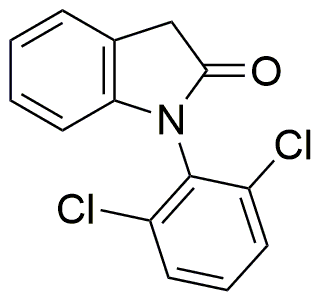1-(2,6-Dichlorophenyl)oxindole is widely utilized in research focused on:
- Pharmaceutical Development: This compound is explored for its potential as an anti-cancer agent, particularly in targeting specific cancer cell lines, making it a valuable candidate in drug discovery.
- Neuroscience Research: It has shown promise in studies related to neuroprotection and neurodegenerative diseases, providing insights into therapeutic strategies for conditions like Alzheimer's and Parkinson's.
- Biochemical Assays: Researchers use this chemical in various assays to study enzyme interactions and metabolic pathways, aiding in the understanding of complex biological systems.
- Agricultural Chemistry: The compound is investigated for its potential use in developing new agrochemicals that can enhance crop protection against pests and diseases.
- Material Science: Its unique properties make it a candidate for developing advanced materials, including polymers and coatings, which can offer improved durability and functionality.
Informations générales
Propriétés
Sécurité et réglementation
Applications
1-(2,6-Dichlorophenyl)oxindole is widely utilized in research focused on:
- Pharmaceutical Development: This compound is explored for its potential as an anti-cancer agent, particularly in targeting specific cancer cell lines, making it a valuable candidate in drug discovery.
- Neuroscience Research: It has shown promise in studies related to neuroprotection and neurodegenerative diseases, providing insights into therapeutic strategies for conditions like Alzheimer's and Parkinson's.
- Biochemical Assays: Researchers use this chemical in various assays to study enzyme interactions and metabolic pathways, aiding in the understanding of complex biological systems.
- Agricultural Chemistry: The compound is investigated for its potential use in developing new agrochemicals that can enhance crop protection against pests and diseases.
- Material Science: Its unique properties make it a candidate for developing advanced materials, including polymers and coatings, which can offer improved durability and functionality.
Documents
Fiches de données de sécurité (FDS)
La FDS fournit des informations de sécurité complètes sur la manipulation, le stockage et l’élimination du produit.
Spécifications du produit (PS)
Le PS fournit une description complète des propriétés du produit, notamment sa composition chimique, son état physique, sa pureté et les exigences de stockage. Il détaille également les plages de qualité acceptables et les applications prévues du produit.
Certificats d'analyse (COA)
Recherchez des certificats d'analyse (COA) en saisissant le numéro de lot du produit. Les numéros de lot et de lot se trouvent sur l'étiquette d'un produit, après les mots « Lot » ou « Lot de fabrication ».
Numéro de catalogue
Numéro de lot/série
Certificats d'origine (COO)
Ce certificat d'exploitation confirme le pays dans lequel le produit a été fabriqué, et détaille également les matériaux et composants utilisés et s'il est issu de sources naturelles, synthétiques ou autres sources spécifiques. Ce certificat peut être requis pour les douanes, le commerce et la conformité réglementaire.
Numéro de catalogue
Numéro de lot/série
Fiches de données de sécurité (FDS)
La FDS fournit des informations de sécurité complètes sur la manipulation, le stockage et l’élimination du produit.
DownloadSpécifications du produit (PS)
Le PS fournit une description complète des propriétés du produit, notamment sa composition chimique, son état physique, sa pureté et les exigences de stockage. Il détaille également les plages de qualité acceptables et les applications prévues du produit.
DownloadCertificats d'analyse (COA)
Recherchez des certificats d'analyse (COA) en saisissant le numéro de lot du produit. Les numéros de lot et de lot se trouvent sur l'étiquette d'un produit, après les mots « Lot » ou « Lot de fabrication ».
Numéro de catalogue
Numéro de lot/série
Certificats d'origine (COO)
Ce certificat d'exploitation confirme le pays dans lequel le produit a été fabriqué, et détaille également les matériaux et composants utilisés et s'il est issu de sources naturelles, synthétiques ou autres sources spécifiques. Ce certificat peut être requis pour les douanes, le commerce et la conformité réglementaire.


